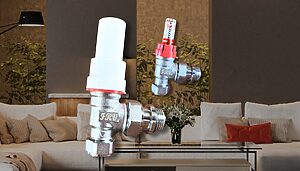The Importance of Radiator Balancing for Efficient Heating: Introducing the Flow Regulating Valve
It’s fascinating to watch how low-temperature heating is evolving in the UK. For decades, domestic heating has largely been defined by the simplicity and forgiving nature of fossil fuel boilers. Stick a gas or oil boiler in a home with any radiators and it’ll usually cope, no matter how slapdash the system design might be.
But heat pumps have changed the game. Unlike boilers, heat pumps demand finesse, care and a touch of engineering discipline to deliver their best. They reward good design and punish lazy shortcuts. And one area that’s gaining more attention (but still doesn’t get the headlines it deserves) is radiator balancing.
In traditional boiler systems running at higher flow temperatures (70C+) you can get away with poor balancing. One radiator might boil you out of the living room while the spare bedroom stays stubbornly chilly, but the boiler just keeps pumping out heat, masking the imbalance with brute force.
With heat pumps, it’s different. Because they run at lower flow temperatures (typically 35-50C) you don’t have that huge headroom to paper over design flaws. Every degree counts. If the flow rates through your radiators aren’t right, you’re more likely to find cold spots, inconsistent room temperatures and higher running costs.
A well-balanced system ensures the right amount of heated water reaches every radiator. That means each room warms up as it should, the heat pump operates more efficiently, and you enjoy steady, comfortable warmth without some rooms feeling like saunas while others never get warm enough.
The Balancing Act: Easier Said Than Done
Traditionally, balancing means tweaking each radiator’s lockshield valve to control how much water flows through it. It sounds simple on paper but in reality, it’s a fiddly, time-consuming process that few installers do well, and even fewer homeowners attempt at all.
Ask any heat pump installer what’s involved and you’ll probably get a wry smile. It’s a painstaking cycle of adjusting one radiator, then another, then another, then going back to check the first one because your previous tweak has thrown it out of balance again.
So for years, balancing has been a best practice that’s often neglected or done half-heartedly. But when you’re spending £10,000-£20,000 on a heat pump system that could cost you thousands to run over its lifetime, it really shouldn’t be optional.
Enter the Flow Regulating Valve
This is where a new product comes in that’s turning heads among heating pros: the Flow Regulating Valve, or FRV for short.
At first glance, the FRV is deceptively simple. It replaces your radiator’s standard lockshield valve, but unlike the old-school version, it lets you quickly and precisely set and check the exact flow rate for each radiator.
No more guesswork with screwdrivers and temperature probes. No more vague instructions about “turning it a quarter turn and hoping for the best.” With the FRV, you fit the valve, consult the simple flow rate chart to find the right setting for that radiator, adjust the dial to the correct flow rate, and you’re done.
The clear visual indicator shows you exactly what’s happening inside. Once set, the valve holds the flow steady, ensuring each radiator gets exactly the right share of heat, all the time.
You can still use TRVs (thermostatic radiator valves) at the other end if you want extra room-by-room control which is handy in rooms with big windows or unpredictable heat gains. But the real magic is that the balancing is now built into the system by design, not left to chance.
Perfect for Heat Pumps... and Boilers Too
While the Flow Regulating Valve is a game-changer for low-temperature heat pump systems, it’s just as useful on conventional gas, oil and biomass boilers. After all, any hydronic system benefits from better flow balance, whether you’re running weather compensation, open loops or good old on/off boiler control.
The FRV is also a retrofit dream. Just swap out the old lockshield valve for the FRV, set it up and forget about it. No massive system overhaul, no smart gadgets that break or need an app... just simple, robust engineering that does what it says on the tin.
A Little Bonus for RHH Readers
We’re excited to share that the team at Firepower, who distribute and sell the Flow Regulating Valve, have given us an exclusive 10% discount code for our community.
If you’d like to get the discount, just email us (editor@renewableheatinghub.co.uk) and we’ll send the code straight to your inbox.
Balancing radiators might not be glamorous, but it’s one of the most impactful things you can do to make your heating system, especially a heat pump, perform to its full potential. On the surface of it, the Flow Regulating Valve makes that job easier, quicker and more accurate than ever before.
If you’re serious about comfort and keeping running costs down, this is one piece of kit worth looking into.
Get a copy of The Ultimate Guide to Heat Pumps
Subscribe and follow our YouTube channel!
Great video again this week @editor, I am very interested in the FRV valves referenced in the part about balancing. I had a disastrous attempt at balancing my rads last time around and basically gave up and just opened them all up again. I got the rads to all be about DT5 but the next day after I headed of to work the system went crazy and sounded like it was going to explode, leading to a severe bollocking from the missus who had to deal with it. Note self never ever tinker with the system unless you are around to fix it lol!
Are these the magic bullet I need? And do I need them on every radiator?
https://www.firepowerheating.co.uk/frv
Kind Regards
Si
——————————————————————————
Grant Aerona3 13kW
13 x 435w + 13x 480w Solar Panels
Sigenergy 10kW Inverter
16kW Sigenstor battery
@grantmethestrength, the podcast episode you mentioned (link below for others) was one of the most interesting and eye-opening we’ve done. It was a real lightbulb moment in understanding how much efficiency and comfort can be lost through poor system balancing. Despite the episode title focusing on pipe sizing, we actually spent a lot of time discussing radiator balancing and its impact.
The FRV you’ve mentioned sounds like a really promising bit of kit. We’re finally getting around to re-piping our frankly bodged system (it’s going to be quite the overhaul) and we’ll be fitting FRVs on all radiators as part of that work.
To answer your question: yes, they need to be fitted on all rads to allow for full balancing. The only downside is that you’ll need to drain your system to install them. I can’t yet say whether they’re a silver bullet, and people have only just started fitting them, so this winter will be the first real-world test. But on paper and in theory, they sound like they could sort out a lot of the issues in a poorly balanced system like ours (and the sound of things, yours).
If you decide to go for it, drop me a DM or email… I’ve got a 10% voucher code I can send you.
Get a copy of The Ultimate Guide to Heat Pumps
Subscribe and follow our YouTube channel!
Posted by: @grantmethestrengthGreat video again this week @editor, I am very interested in the FRV valves referenced in the part about balancing. I had a disastrous attempt at balancing my rads last time around and basically gave up and just opened them all up again. I got the rads to all be about DT5 but the next day after I headed of to work the system went crazy and sounded like it was going to explode, leading to a severe bollocking from the missus who had to deal with it. Note self never ever tinker with the system unless you are around to fix it lol!
There are a couple of subtle points to make here which might explain the noise you experienced:
1: did you ensure that, when you balanced them, the LSV on at least one radiator (normally the one furthest from the heat source, but maybe also a couple of adjacent ones) was fully open (and yet still in balance).
2: Balancing for DT5 is a mistake unless the design is perfect (which it almost certainly isnt) and the OAT is the design OAT and has been for at least 24 hrs (which is rarely if ever the case).
Getting wither of these wrong will lead, in most cases, to turning the LSVs down too far and thus throttling the flow unnecessarily, increasing noise and wear on the water pump and increasing running costs.
The objective is just to achieve 'balance' ie either the same DT (not necessarily 5, in many cases it will be less) across each radiator or the same room temperature (or the desired difference in room temperature) in each room, whilst keeping the valves as open as possible so as not to restrict flow more than is necessary. Hence why you should start with and maintain at least one LSV fully open and not worry about adjusting the LSVs for DT5 (if, for some reason, you want to adjust for DT5 then its the water pump speed that should be changed).
4kW peak of solar PV since 2011; EV and a 1930s house which has been partially renovated to improve its efficiency. 7kW Vaillant heat pump.
@jamespa You are right I must have cranked them down too much. I am struggling to get my noodle around what balancing is I thought it was getting the DT the same on each radiator so I am obvs not grasping the fundamentals of it. But thanks for the explanation. I think I am falling into most of the categories you mention incorrect design, not at design OAT etc. As was said in the video balancing a radiator is a simple task in principle 😝
Kind Regards
Si
——————————————————————————
Grant Aerona3 13kW
13 x 435w + 13x 480w Solar Panels
Sigenergy 10kW Inverter
16kW Sigenstor battery
Posted by: @grantmethestrengthI am struggling to get my noodle around what balancing is I thought it was getting the DT the same on each radiator
My understanding (someone may correct me) it that it is this, but not a specific DT for the reasons outlined above. Alternatively its getting the same flow rate. In a system where the radiators are precisely sized to match the load, they will occur at the same point. In both cases, however, the aim is to do so without restricting flow more than you absolutely need to.
A refinement is is getting the same room temperature (or the desired differences in room temperature). This 'takes out' the inevitable variations in radiator sizing from the ideal. Heat Geek says something about this in their videos on balancing.
In reality any of these may be good enough (because rooms share heat) unless you have gross imbalances in radiator sizing in which case the last is what you really want, but its much more time consuming.
If you are going to balance for same DT then it needs to be large enough to be measurable. Some heat pumps turn their water pump speed up or down to maintain eg DT5 at the heat pump, but many don't and so DT is going to be <5 most of the time. If yours doesn't then, at this time of year, the DT wont be large enough to measure unless you whack the flow temperature up well above the target so the house overheats, and then allow it to stabilise for a while. Similar considerations apply to balancing for same room temp. It may be that professional installers (which I am not) have some other tricks to deal with this.
FWIW I found balancing my house, at least to a 'comfort' point, quite easy. After doing a very rough balance for DT (really no more than the 'feel' test plumbers reputedly use - effectively making sure all rads are getting a reasonable flow and at least one is fully open), I simply turned down a couple where the room overheated, and turned up a couple where the room underheated. Fortunately it was cold outside so it was relatively easy. Perhaps I could do better with a more precise/scientific balancing, but its comfortable, I get a COP I'm happy with and I have other things to do in life!
4kW peak of solar PV since 2011; EV and a 1930s house which has been partially renovated to improve its efficiency. 7kW Vaillant heat pump.
Posted by: @jamespaPosted by: @grantmethestrengthI am struggling to get my noodle around what balancing is I thought it was getting the DT the same on each radiator
I get a COP I'm happy with and I have other things to do in life!
I may need to adopt this technique lol!
Kind Regards
Si
——————————————————————————
Grant Aerona3 13kW
13 x 435w + 13x 480w Solar Panels
Sigenergy 10kW Inverter
16kW Sigenstor battery
When adjusting the FRV you need to use the area of the radiator. Does the radiator type (K1, K2, K3 etc) need to be taken into account?
Posted by: @fred-grayWhen adjusting the FRV you need to use the area of the radiator. Does the radiator type (K1, K2, K3 etc) need to be taken into account?
Good question. Based on physics I think the short answer is yes.
I have actually been thinking about this area since I posted above with the comment that balancing for DT and balancing for equal flow rate will achieve the same result.
I now think I was wrong and your question has cemented my belief that Im wrong. If you balance flow rate per unit output it will result in equal deltaT. The output for any particular rad type is proportional to area, but the proportionality constant is different depending on the radiator type (K1, K2, K3, K+)
I just looked at the FRV data sheet and it says to multiply by the area, but doesn't specify the radiator type. Something isn't right!
@editor I think you are in contact with these guys, maybe you know?
4kW peak of solar PV since 2011; EV and a 1930s house which has been partially renovated to improve its efficiency. 7kW Vaillant heat pump.
@jamespa that is quite important. It would be good if they had a video tutorial on how to set them up, with some examples of the maths for us dummies! I wonder if you would put one on the rad that is supposed to be fully open?
Kind Regards
Si
——————————————————————————
Grant Aerona3 13kW
13 x 435w + 13x 480w Solar Panels
Sigenergy 10kW Inverter
16kW Sigenstor battery
Posted by: @grantmethestrengthI wonder if you would put one on the rad that is supposed to be fully open?
With their balancing process Im pretty sure all rads could end up being restricted at least a bit. Its unlikely however that the restriction would be so great as to cause a problem. Personally I would probably adopt a slightly different process but the difference would be marginal.
Doing some maths on their figures 1.3l/min/sqm at DT5 is 1.3*5*4200/60 = 455W/sq m (assuming water not glycol).
At room DeltaT of 20 thats equivalent to (20/50)^1.3 =1496W/sqm at room DeltaT of 50 (which is how rads are normally quoted).
Stelrad Type 11 500mm high rads are quoted as 1548W/sq m at room DeltaT50, so it seems that the figures in the FRV leaflet are for Type 11.
The Stelrad figures for other variants, and the ratio relative to type 11, are
Type - W/sqm - ratio relative to Type 11
11-1548-1
21-2106-1.4
22-2666-1.7
33-3786-2.44
Assuming my logic is right that enables the calculation to be done for other rad types.
So, for example, a 0.5m*1.2m (0.6sqm) type 22 needs a flow rate of 0.6*1.3 * 1.7 =1.33l/min to get DT5 at 20C room to rad deltaT.
4kW peak of solar PV since 2011; EV and a 1930s house which has been partially renovated to improve its efficiency. 7kW Vaillant heat pump.
Watched the latest homeowners qa and they mentioned some easy to balance lock shield valves. It’s something I need to look at in the winter as not had the HP that long. Or if they are not an option is there a reasonably accurate, or one I can calibrate, temp meter I can use to balance them.
Currently viewing this topic 5 guests.
- 26 Forums
- 2,381 Topics
- 54 K Posts
- 531 Online
- 6,065 Members
Join Us!
Worth Watching
Latest Posts
-
RE: Recommended home battery inverters + regulatory matters - help requested
I believe you will need a separate earth if considering...
By Old_Scientist , 6 hours ago
-
RE: New Fogstar 15.5kWh upright solution
@batpred It's a shame you haven't bought any of thes...
By Bash , 8 hours ago
-
RE: Solar Power Output – Let’s Compare Generation Figures
@transparent 1P only. Wish I was on 3P, we have a lo...
By Papahuhu , 9 hours ago
-
RE: Octopus Cosy Heat Pump Owners & Discussion Thread
@jamespa There is no reason the Cosy couldn't auto-bala...
By swwils , 9 hours ago
-
RE: Connecting Growatt SPH5000 over wired ethernet rather than wireless
Well well well.. turns out my WiFi dongle is actually t...
By z8lccda , 10 hours ago
-
RE: Solis S6-EH1P8K-L-PLUS – Why I Chose It and What I’ve Learned So Far
I am now considering adding a second battery to my setu...
By Batpred , 12 hours ago
-

@abam48 Did you go for this option and does it work wel...
By dgclimatecontrol , 14 hours ago
-
RE: Weather compensation- why you should use it
Okay thanks both. Yes the house is very nic...
By jamesh , 15 hours ago
-
RE: Cascade 2x Grant Areona 10kw ASHP - Ongoing setup issues
Well this morning the master bedroom & ensuite were...
By adam , 16 hours ago
-
Happy New Year to all fellow tinkerers. I've been doin...
By Sheriff Fatman , 16 hours ago
-
RE: Gen 6 Samsung ASHP losing 20C of DHW in 60 min directly after generation
@andbeck Couple of questions and a thought: I can...
By JamesPa , 17 hours ago
-

RE: Setback savings - fact or fiction?
That is correct, the setback period was Feb to Apr 2025...
By cathodeRay , 19 hours ago
-
RE: Havenwise App Help & Forum Support – Get the Most from Your Heat Pump
Fair enough. The reason for asking was that Henri's po...
By Sheriff Fatman , 19 hours ago
-
RE: Eve Thermo Gen 5 Smart TRV
Interesting. Are they getting bunged up do you think, ...
By JamesPa , 19 hours ago
-

Thanks for your comments @old_scientist. It sounds like...
By SUNandAIR , 20 hours ago
-
RE: Radiator sizing sanity check
@jamespa Thanks for the help. Yes, I’m going to push fo...
By Papahuhu , 20 hours ago
-
RE: Help needed with Grant Aerona 3 issues
@fleurcules thats great news. My advice is to make sur...
By JamesPa , 21 hours ago
-
RE: Optimum new build house design for Heat Pump
The spacing needs to be designed though a software or b...
By ASHP-BOBBA , 21 hours ago
-

@jamespa I share your cynicism. I do suspect there’s a...
By Mars , 1 day ago
-

RE: Global Energy Systems Thurso ASHP
Great point Benson. In winter, on mild days, our 18kW w...
By Mars , 1 day ago







